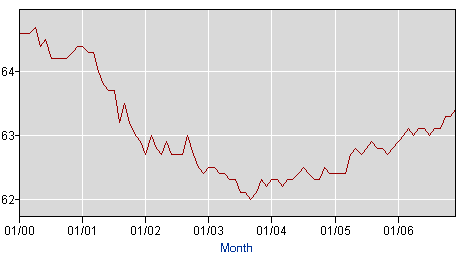May 04, 2012
I really don’t like to beat up on Ben Bernanke. I don’t know him personally, but everyone I know who does says that he’s a really nice guy. And, there is no doubt he is a very smart economist. But he shares the blame for the downturn with his former boss, Alan Greenspan. Even worse, he still seems resistant to getting the story right.
He gave a speech last month in which he forgives himself and others in policy positions for being surprised by the dangers posed by the collapse of the housing bubble. He noted that we lost $10 trillion in wealth when the stock bubble collapsed and that was no big deal. Why should we have expected it to be a big deal when we lost $10 trillion in wealth when the housing bubble collapsed? He then goes on to comment on the wonders of bank leverage and financial crises.
Bernanke should know that both sides of his assertion are seriously misleading. First, the wealth lost in the stock crash was stock wealth. The wealth effect from consumer spending on stock wealth is generally estimated to be much lower than the wealth effect from housing wealth. The range from the former is typically estimated at 3-4 cents on the dollar, as opposed to 5-7 cents on the dollar from housing wealth.
Also, housing wealth has a much more direct effect on stimulating demand through construction than stock wealth has in boosting investment. Residential construction was more than 2.0-3.0 percentage points of GDP ($300-$450 billion a year in today’s economy) above its trend level at the peak of the bubble. By contrast, the investment generated by the stock bubble was no more than 1-2 percentage points of GDP.
More importantly, the loss of wealth from the stock bubble was temporary. If Bernanke consulted the data (Table L.213) that his organization publishes, he would notice that by March of 2004, the stock market had already recovered more than half of the value it had lost. Its valuation at that point was only a bit more than $4 trillion off its 2000 peak and was actually above the 1998 year-end level. Since no one spends based on daily movements in the stock market (i.e. there is a lag between when stock prices rise and when people adjust their spending), the negative wealth effect at that point would have been limited.
By contrast, housing wealth has continued to decline. We have now lost close to $8 trillion in real housing wealth compared to the bubble peak in 2006. And, there is no plausible story whereby housing wealth will come back quickly.
The other part of Bernanke’s story that is wrong is that the collapse of the stock bubble was no big deal for the economy. While the official recession was short and mild, lasting from March of 2001 to November of 2001, the economy continued to lose jobs through 2002 and didn’t start to create jobs again until September of 2003. This is shown clearly in the employment to population rate; data that I recall Bernanke citing in a talk in January of 2004 when he was explaining why it was necessary for the Fed to still keep the federal funds rate at the extraordinarily low level of 1.0 percent.
Employment-to-Population Ratio

Source: Bureau of Labor Statistics.
The reason why this argument is important is that financial crisis can be complicated and mysterious. They are hidden in complex financial assets on balance sheets that almost no one sees.
By contrast, bubbles are simple. They sit there expanding in broad daylight. Could any sentient being miss the stock bubble or the housing bubble?
And, the demand gap created by their collapse is really straightforward. Residential construction is off by 4.0 percentage points of GDP as we deal with a badly overbuilt housing market. That’s $600 billion a year in lost demand. Consumption has also plunged, with the saving rate going from near zero at the peak of the bubble to 4-5 percent at present. That implies a loss in annual consumption demand of $400-500 billion. Add in another $200-$300 billion in lost demand due to the collapse of the bubble in non-residential real estate and the contraction of the state and local government sector in response to lost tax revenue and you have a gap in annual demand of $1.2-$1.4 trillion.
This is all very simple. The arithmetic we learn in third grade should cut it.
By contrast, what are the financial crisis promulgators talking about? I enjoyed the crisis as much as anyone, but what demand should we be seeing right now that we are not seeing because we had the financial crisis?
That is a real simple question that I would like to hear answered. Consumption is actually still unusually high relative to disposable income. The financial crisis cult thinks it should be higher, why?
Investment in equipment and software is almost back to its pre-recession share of GDP. That is very impressive given the large amounts of excess capacity in most sectors. Even non-residential construction has bounced back, in spite of the overbuilding in many sector due to the bubble.
In short, if the crisis cult has a story let’s hear it. If they don’t have a story, then Bernanke and his followers should look for another line of work.







Comments